Halloween Timeline Explained for Wild Horror Movie Franchise
For a series of movies about a guy in a mask holding a knife, the Halloween franchise has a wildly complex movie timeline. Several of them, actually!
This article contains HAlloween Ends spoilers.
There are plenty of iconic slasher movie franchises that have become emblematic with the Halloween season. When it comes to holiday horrors, however, it’s hard to beat John Carpenter’s prototypical slasher classic, Halloween, which first introduced unsuspecting audiences to the blunt, brutal evil of Michael Myers. Michael, also known as “The Shape,” has terrified horror fans for more than 40 years, and the boogeyman has endured so long because there’s a scary simplicity to the cipher. Michael Myers is an evil force of nature and there’s something deeply unsettling about his unstoppable presence.
The Halloween franchise has experienced an inconsistent run across its first 10 films until David Gordon Green and Blumhouse were able to breathe fresh life into Michael’s stiff corpse. And their legacy sequel approach has brought Halloween back to its roots. The series’ current timeline builds upon the events of the original 1978 masterpiece. However, to only look at the events of these four films—the original movie plus current trilogy masterminded by Green—does a serious injustice to the many twists and turns that are present in the earlier sequels and reboots. Indeed, before “reboot” was even an industry term, the Halloween franchise has been doing this several times over while crafting its own Gordian knot of continuity.
Audiences may now be ready to finally receive closure on the Michael Myers and Laurie Strode conflict, but this showdown means even more in the context of the franchise’s grander convoluted chronology. After this refresher on all things The Shape, you’ll be a bigger expert on Michael Myers than ol’ Sam Loomis and the Cult of Thorn combined.
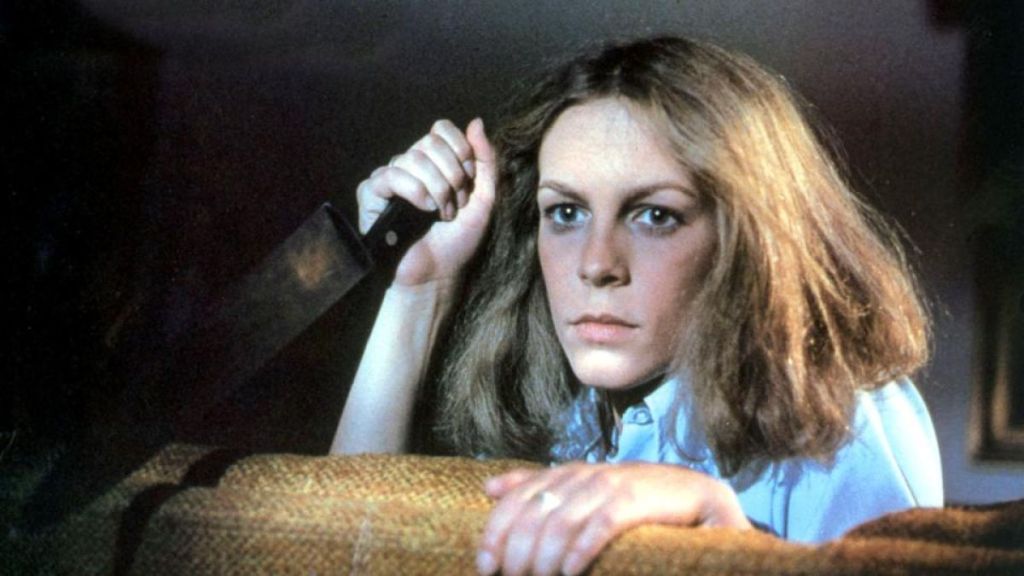
Halloween
1963 – 1978
The film opens up in 1963 and provides the first glimpse of a young Michael Myers when he stabs his older sister Judith to death on Halloween night. Michael is hospitalized at Warren County’s Smith’s Grove Sanitarium following the attack. Fifteen years later on Oct. 30, 1978, Michael is on his way to be escorted to court when he steals Dr. Samuel Loomis’ car to escape back to his hometown of Haddonfield, Illinois.
Once there, Michael murders a mechanic to get his classic workman’s uniform and also acquires his now iconic mask and knife from a hardware store. The following night is when Michael begins his killing spree and develops his obsession with Laurie Strode. The first Halloween film concludes with Loomis saving Laurie by shooting Michael six times and knocking him off a balcony.
Yet his body is missing when they go to examine it…

Halloween II
1978
The sequel picks up immediately after the events of the first film, even though it was produced three years later. Laurie is hospitalized following her attack, and Michael follows her over to Haddonfield Memorial Hospital and carries out a murderous rampage on everyone that tries to keep him away from Laurie.
This is the film that also reveals Laurie is Michael’s younger sister, who was given up for adoption as an infant. Not only is this familial connection provided, but the film adds in some more supernatural lore. Michael is driven to kill his younger sister in order to fulfill the curse of Samhain. The film concludes with the threat of Michael Myers supposedly over when an explosion that Dr. Loomis causes consumes both himself and Michael.
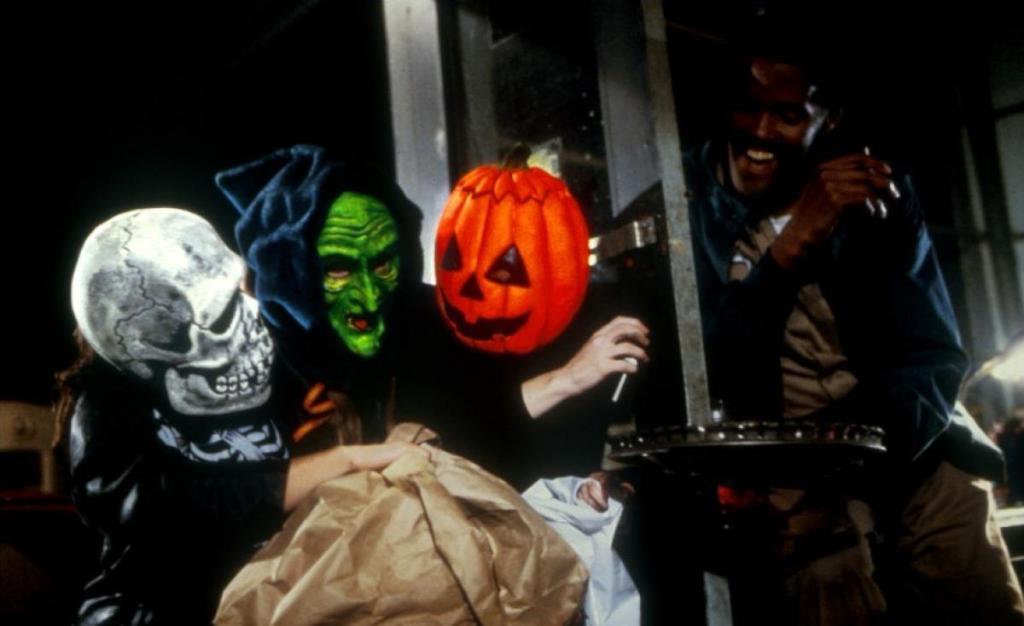
Halloween III: Season of the Witch
1982
At this point, it was John Carpenter’s intention to end the Michael Myers portion of Halloween and turn the series into an anthology where each film would tell a different horror story set on Halloween night. 1982’s Halloween III: Season of the Witch is the first (and only) step in this direction. The film looks at an evil novelty company that uses the magic of Stonehenge to weaponize Halloween masks against children (it’s amazing, though). It also featured the most spectacular jingle from hell you’ll ever endure.
When fans weren’t responsive to this change to the series, Carpenter’s anthology plan was scrapped, and Michael would be back in full force in the following entry. However, when Jamie Lee Curtis declined to return to the series, Halloween had to set up a new target for Michael, which leads into the “Jamie Lloyd Saga” of the next three films. We wrote more about why this movie deserves another chance right here.
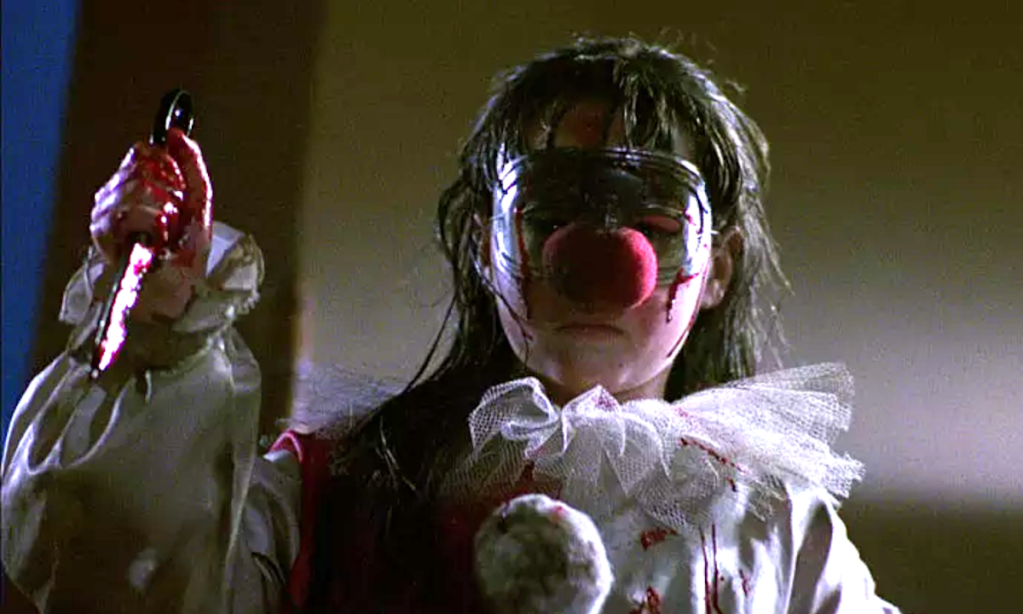
Halloween 4: The Return of Michael Myers
1988
The first soft-reboot of the franchise has to suspend a little disbelief so that both Michael and Loomis survive their fiery deaths at the end of Halloween II. Now, despite being visibly turned into a blind slab of barbecue, Michael has a few scars and is doing fine, awakening 10 years after the fact from a coma. He’s in the process of being transferred back to Smith’s Grove Sanitarium, but upon hearing that not only has Laurie Strode died in a car accident, but that she also left behind an eight-year old daughter, Jamie Lloyd (and thus Michael’s niece), The Shape awakens and does the whole murder and escape thing. He returns to Haddonfield to track down wee little Jamie, her older foster sister, Rachel, as well as a back-in-action Dr. Loomis, who is hot on their trail.
Since mere bullets and fire aren’t enough, Loomis takes out Michael this time by shooting him up with a shotgun and knocking him down a mineshaft. The film attempts a shocking final visual that sees Jamie in a similar clown costume to the one Michael wore back in the prologue to the original film. Jamie goes on to attack her foster mother with a knife and with Michael now out of the picture, it looked like Jamie would become the killer in the following entry as this evil passes on. Dr. Loomis even attempts to shoot her before he is thwarted by the police and Jamie’s foster father.
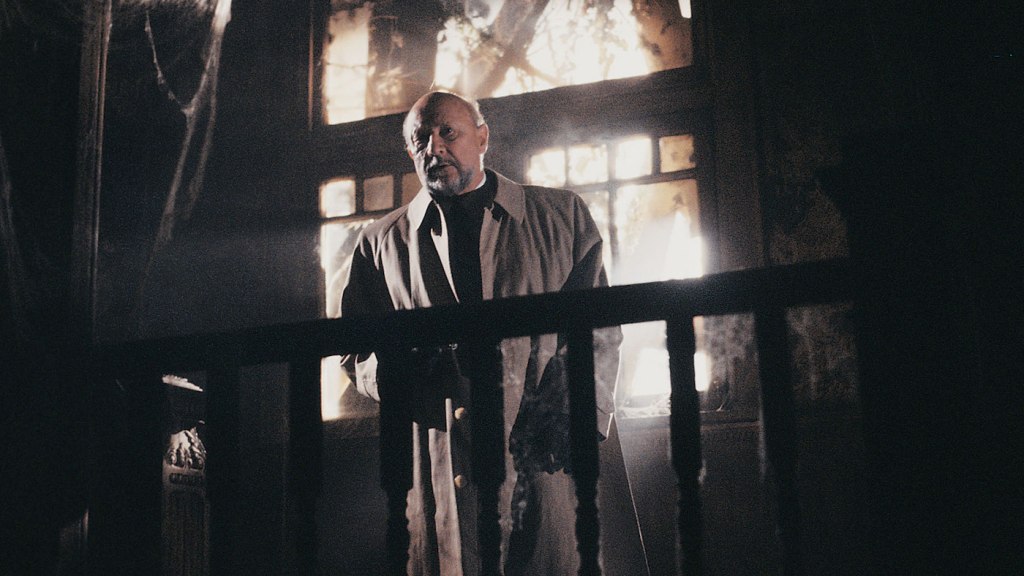
Halloween 5: The Revenge of Michael Myers
1989
However, the next movie abandons that plan for more and more Michael. Jamie has been in a children’s mental health clinic for months after her outburst at the end of Halloween 4; she is also completely normal despite her “episode” and is visited regularly by Rachel and a much cuddlier Dr. Loomis, if not her traumatized foster parents. Michael has also taken a year to nurse himself back to health and survive the onslaught of an attack he received.
The film establishes some sort of psychic connection between Michael and Jamie, and it allows him to once again track her down. Rachel meets her unfortunate end, but Loomis is successful in capturing Michael and putting him away in custody. Halloween 5 boldly goes out on a legitimate cliffhanger to set up the final film in this new trilogy. An obscured “Man in Black” cult figure breaks Michael out of prison and implies that he’s a part of something bigger—something the filmmakers clearly had no idea how to explain when they shot it.
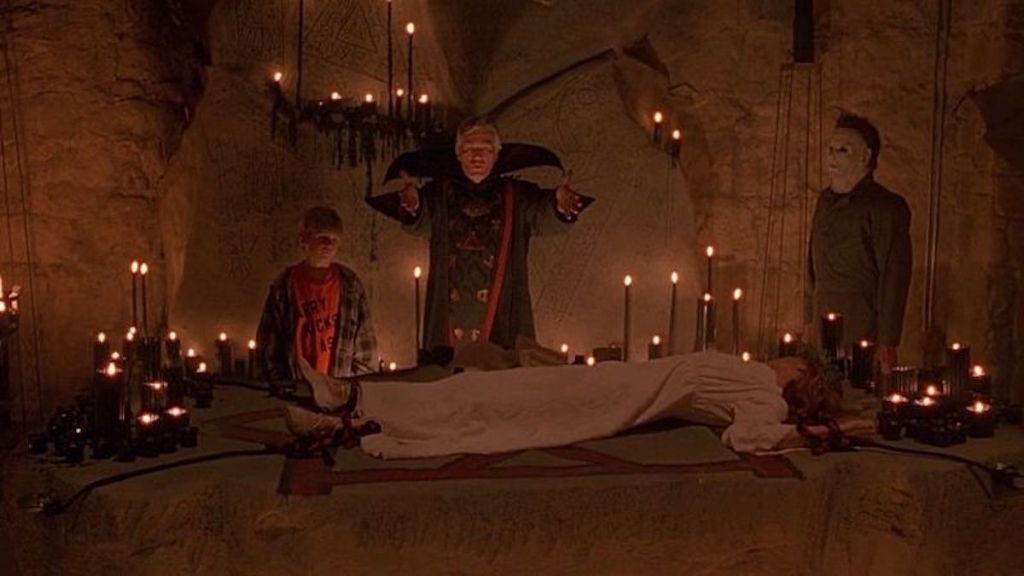
Halloween: The Curse of Michael Myers
1995
This belated follow-up really goes all in with the supernatural mythology and attempts to explore the source of Michael’s evil. There are dramatically different events that occur in the movie depending whether audiences watch the original theatrical release or the more supernaturally-tinged producer’s cut. We’ll touch upon a mix from both cuts here.
This curse indicates that Michael becomes the cult’s vessel and is forced to murder his entire family as some kind of sacrifice for the protection of mankind. The Cult of Thorn are all chosen people (they’re literally branded) who risk everything to protect their vessel so that he can complete their goal. This is all fairly silly (and also contradicts the Samhain curse from Halloween II), but largely becomes the focus of the film.
The Curse of Michael Myers picks up six years after the prior film and reveals that the Cult of Thorn—the same individuals who rescued Michael from jail in the fifth movie—also kidnapped Jamie Lloyd (who’s been recast from fan favorite Danielle Harris to J.C. Brandy) in order to help fulfill their prophecy. The Cult uses Michael to impregnate Jamie and after she gives birth to Michael’s son, he messily kills her with farm equipment. Still, he can’t track down her child.
Curiously, a grown-up Tommy Doyle—the boy that Laurie babysits in the original Halloween—finds the child and opts to protect it from Michael. Oh, and Tommy Doyle is played by Paul Rudd. The Curse of Michael Myers goes out on another cliffhanger as Tommy heavily sedates Michael with tranquilizers and Loomis is branded as Michael’s new guardian in the Cult of Thorn. As interesting of a direction as this would have been, Donald Pleasence’s death effectively ended those plans and this more or less ends the first full Halloween timeline in 1995, where it is implied Michael finally kills Dr. Loomis off-screen (we hear what sounds like his cries).
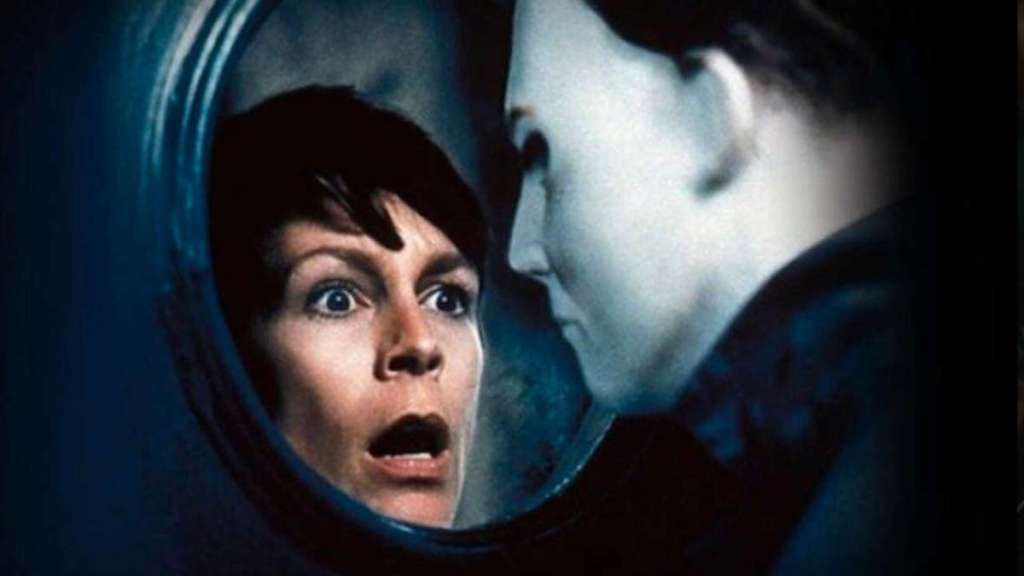
Halloween: H20 (The First Major Reboot)
1998
1998 marked the 20th anniversary of the original film, and so the series decided to take a rather different approach and put out Halloween H20: 20 Years Later. The film marks the second timeline in the franchise and is set 20 years after the conclusion of Halloween II, choosing to ignore the Jamie Lloyd material (although the character was mentioned in the original script, which is interesting, if not confusing). Laurie has faked her death and changed her name to Keri Tate so as to elude Michael for all of these years.
Michael in turn uses Laurie’s son, John (Josh Hartnett), to get to his true target. The film’s big finish centers on the reunion between these extremely dysfunctional siblings.
Halloween: H20 has an incredibly cathartic conclusion, as Laurie derails a conventional ending of an injured Michael escaping via the ambulance he’s being driven away in (he of course escapes and kills the EMTs). She does this by literally driving Michael off the road and then decapitates her brother as he attempts to guilt her. Laurie is the true hero, she’s conquered her demons, and the canon of Halloween, Halloween II, and H20 would tell a beautiful story if that was it.
But that’s not it…
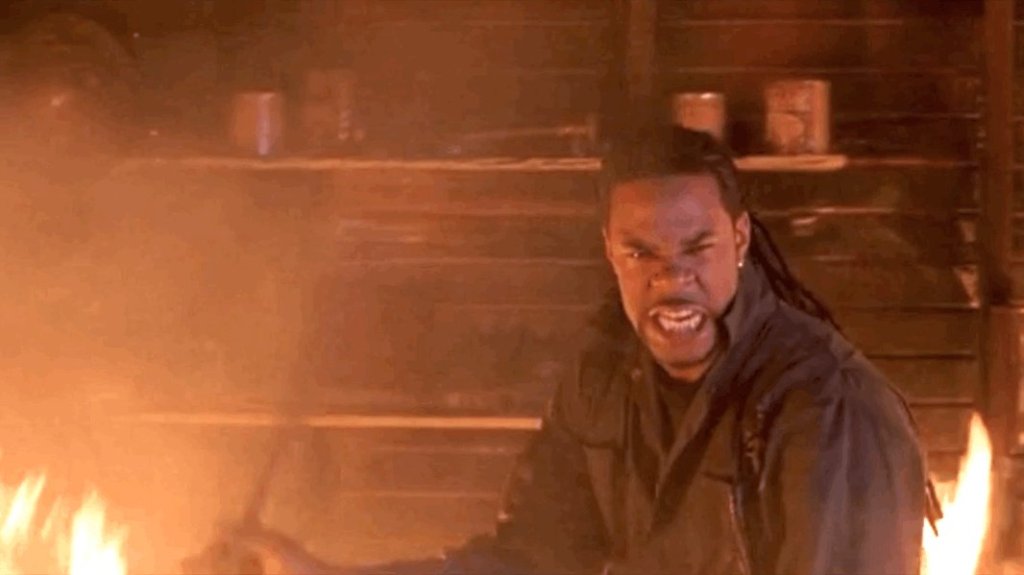
Halloween: Resurrection
2002
Halloween: Resurrection is the absolute nadir of the franchise and it’s the result of money driving a project rather than passion. Jamie Lee Curtis was fairly appalled at how the existence of this film would undercut H20’s ending, and has since inferred she only did the film due to contractual obligations, however she demanded Laurie be killed off in it so that her story would be over.
The film does exactly that and in one swift moment, Halloween: Resurrection’s opening scene undoes all of the goodwill that the previous film earned. A distraught, frightened Laurie is murdered by Michael after spending three years in a mental institution. It’s an awful end to such a powerful character.
Michael also survives his decapitation from H20 courtesy of some rather sloppy retconning. Apparently Michael put his mask on an ambulance driver and switched places with him, so Laurie actually decapitated an innocent man, and her evil brother got away free. This is really what’s important from the film since the rest of Halloween: Resurrection sees a bunch of teenagers set-up an internet reality show in Michael’s childhood home in Haddonfield. Michael doesn’t appreciate the publicity, but Busta Rhymes electrocutes Mikey to death before the film’s over. With that disastrous ending, this timeline’s conclusion sees Busta Rhymes’ reality show producer as the true champion over Michael Myers. The end.
Okay?
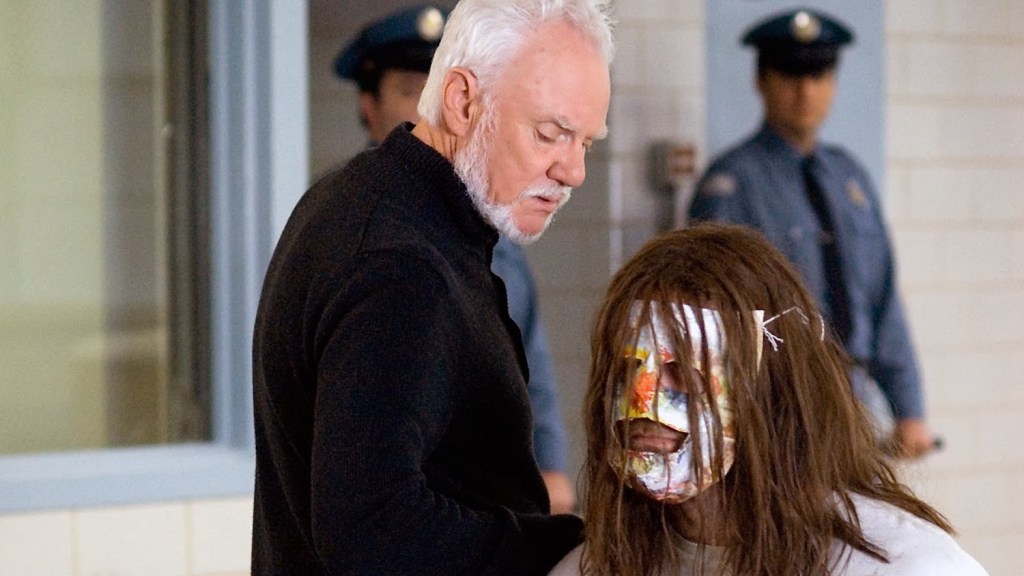
Halloween
1991 – 2007
Technically speaking, this remake is more or less a retelling of the same story as Carpenter’s original film (at least with Halloween II’s sibling angle thrown in). Michael Myers stalks his sister, Laurie Strode, with Dr. Loomis on the hunt to stop him. While the larger story beats are the same, Zombie digs much deeper into Michael’s broken childhood, his relationship with his mother, and the rough life that he had that helped turn him into “The Shape.” He even has an assortment of masks that represent his many emotions, not just the iconic white mask.
More of a character study for its first half, Halloween attempts to find the man and psychology behind the Boogeyman, turning him into a more realistic serial killer whose attacks are truly gruesome.
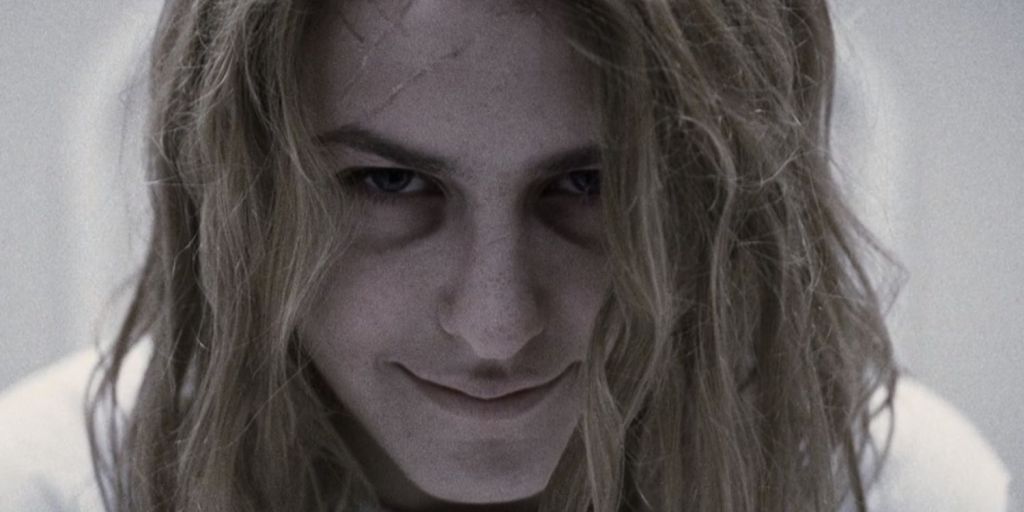
Halloween II
2008
Zombie’s Halloween II (set one year later, though released in 2009) goes more in its own bizarre direction, with Michael finally speaking for the first time as an adult (he says “DIE” as he finally kills Dr. Loomis, played here by the always welcome Malcolm McDoweel), and with Laurie then stabbing Michael to death and being sent to a mental institution, perhaps to continue on the cycle. Like the end of Halloween 4, it is hinted she’s inherited her relative’s madness, especially since Michael killed her best friend over the two movies, Annie, played here by Danielle Harris. Yep, after evading her terrible sendoff in Halloween 6, Ms. Harris still endured the fate all Michael Myers survivors apparently must succumb to.
Even though a sequel was planned, Zombie’s direction for the series was abandoned until David Gordon Green’s vision could finally come to fruition nearly a decade later and 40 years after the release of the original film.
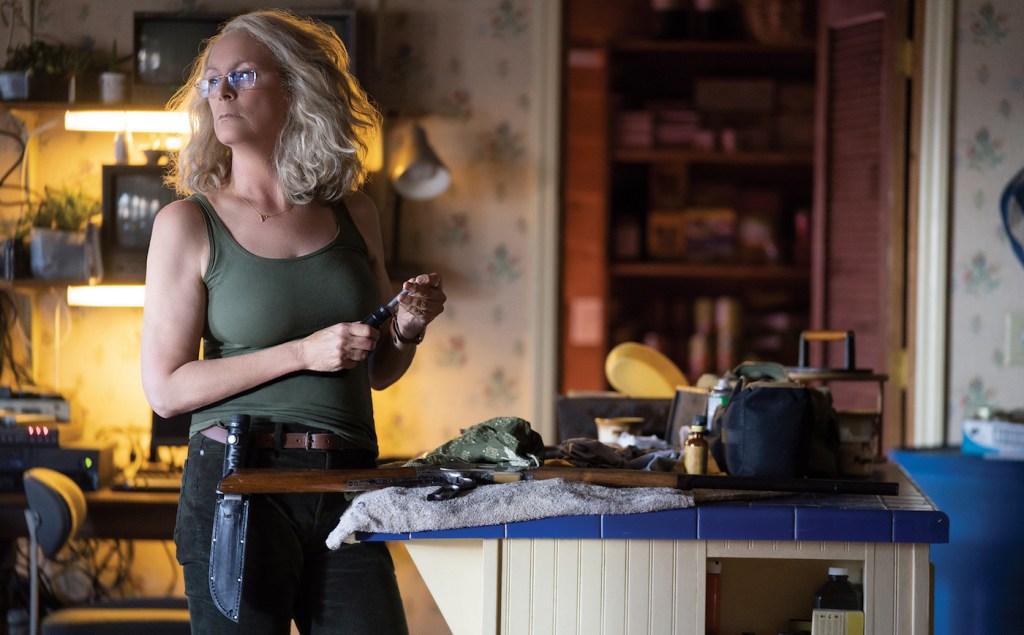
Halloween
2018
David Gordon Green’s Halloween is a return to form and has earned the approval of both Jamie Lee Curtis and John Carpenter. It also very much feels like a soft repudiation of Zombie’s psychological profile and all the many intricacies of, well, canon and timelines. By wiping out everything that came before it, save the original, it returns to the basic elemental horror of Carpenter’s original picture with the aim of having some fun at remembering that Michael was originally the “Shape” before he became Big Brother Mikey, then Uncle Mikey, and finally Busta Rhymes’ vanquished foe, Mikey.
2018’s legacy sequel literally goes out in a blaze of glory as three generations of Strodes spring into action and trap Michael in a burning basement. Fire hasn’t always been the most effective tool against Michael and this satisfying defeat concludes on a note of uncertainty as Michael’s body is nowhere to be found. That being said, the announcement of not one, but two sequels shortly after the film’s release gave audiences a pretty good idea that Michael Myers didn’t return after a lengthy hiatus just to disappear again.
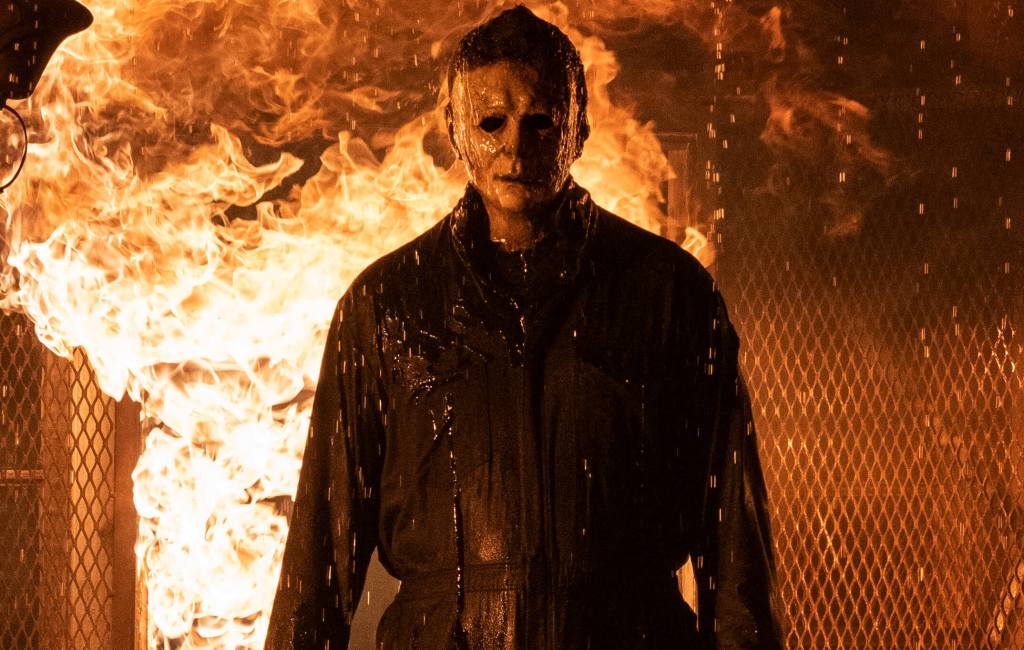
Halloween Kills
1978 – 2018
David Gordon Green’s Halloween helps ease audiences back into the atmospheric horrors of John Carpenter’s original universe, but 2021’s Halloween Kills is a considerably more extreme affair that thrives on excess. The majority of Halloween Kills takes place on Halloween night 2018, as the previous film’s aftermath elevates Michael to what almost feels like a supernatural status. However, the sequel begins with a crucial flashback that’s set in 1978 during the original film’s finale. The circumstances of this prologue are largely designed to refocus the motivations of officer Frank Hawkins (Will Patton) and give him just as much of a stake in Michael’s demise as Laurie.
Curiously, Halloween Kills sidelines Laurie Strode in the recovery ward of Haddonfield Memorial Hospital for the entire film while Michael instead wreaks havoc on the random survivors of the ’78 massacre, such as Tommy Doyle (Anthony Michael Hall), Marion Chambers (Nancy Stephens), and Lindsey Wallace (Kyle Richards).
Halloween Kills presents quite the condensed timeline, but while the entirety of the movie only covers a few hours, it contains one of Michael’s most gratuitous body counts. Michael successfully kills off many of the faces from his past, as well as Laurie’s daughter, Karen Nelson (Judy Greer). Halloween Kills appropriately feels like the middle installment of a trilogy that bides its time before the final showdown. Its commentary on mob mentality and vigilante social justice don’t go deep enough, and Michael’s obsession with his sister’s old bedroom isn’t the breakthrough that it thinks it is.
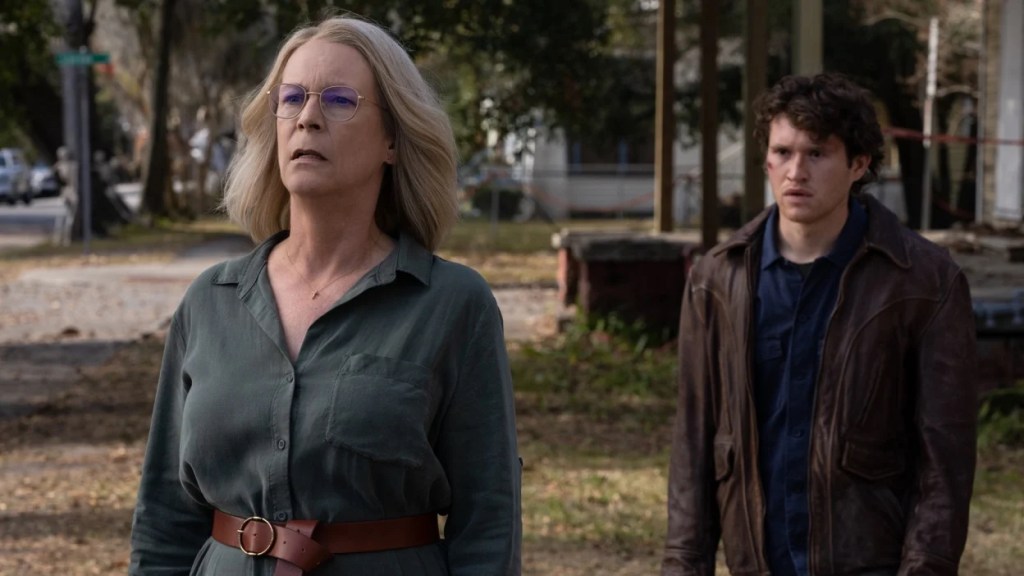
Halloween Ends
2019 – 2022
The original plan for Blumhouse’s modern Halloween trilogy was to have these three films all occur during one extended night of terror. Halloween Kills picks up immediately from the conclusion of 2018’s Halloween. However, Green later decided that with Halloween Ends, they’d let the pain and trauma marinate for a little longer. Set in 2022, four years after the events of Halloween (2018) and Halloween Kills, Laurie Strode and her granddaughter, Allyson (Andi Matichak) seem to have finally found some semblance of peace. Michael hasn’t been seen since the end of Halloween Kills and Laurie has spent the following years processing her pain through a memoir about her four decades of living in fear.
Alternatively, Allyson continues to cope with the loss of her mother through therapy, which introduces her to kindred spirit, Corey Cunningham (Rohan Campbell). Corey’s story actually turns the clock back to 2019, one year after Halloween Kills, back when he becomes a Haddonfield pariah after a freak accident on a babysitting gig brands him as a killer.
In the present, Halloween Ends draws frequent parallels between Corey and Michael, the latter of which retreated to the sewers, presumably to die in peace following his Halloween Kills finale beatdown. Murders begin to break out in Haddonfield and there’s debate over whether Michael has returned or if this is just the work of a deranged copycat.
Halloween Ends ultimately plays into the “multiple Michaels” angle once Corey steals the boogeyman’s mask and clothes so that he can freely get revenge on the locals that still torment him. Halloween Ends asks if evil can change shapes, or if we create our own boogeymen through spreading trauma. Still, the film’s finale properly focuses on Laurie Strode and Michael Myers’ 40+ years of history.
There’s an extremely cathartic fight between Laurie and Michael in her house where she slashes him to pieces and doesn’t make the same non-lethal oversights she has in the past. Then, to guarantee that “evil dies tonight,” Laurie, Allyson, and nearly the whole town take Michael to the junkyard and ceremoniously push him into a metal shredder.
In 2022, 44 years after the original Haddonfield murders, Laurie, her family, and her community can finally move on. As it stands, Blumhouse’s plans with Halloween are over, but that still doesn’t mean that a new team won’t attempt to resurrect The Shape, whether it’s with Michael or Haddonfield’s newest urban legend, Corey Cunningham.
